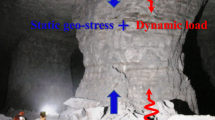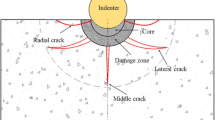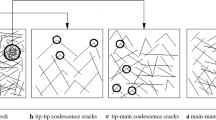Abstract
This paper studied the rock dynamic fracture propagation under impact loads elaborately with a determination method proposed to calculate crack propagation dynamic stress intensity factor (DSIF). By utilizing the split-Hopkinson pressure bar, the impact experiments with an improved single cleavage semi-circle (ISCSC) specimen were conducted to illuminate the dynamic crack propagation behaviour. Meanwhile, the fracture characteristics and crack propagation velocity were obtained by the crack propagation gauges. Coordinating experiments with a numerical approach, the crack propagation dynamic stress intensity factors were calculated by an experimental–numerical method with fractal theory. Then, a finite difference model was developed based on the tensile fracture softening damage criterion. With the analysis of numerical and experimental results, the crack propagation behaviour and mechanism of crack arrest were discussed sophisticatedly. The results demonstrate that the novel ISCSC specimen shows a definite advantage in determining crack propagation and arrest DSIF. Additionally, the crack arrest DSIF is larger than the average propagation DSIF with a sharp increase. Meanwhile, the numerical simulation results which agree well with the actual crack propagation illustrate that the crack arrest should be dominated by the compressive stress perpendicular to the crack path, and there were several arrest pauses existing in the transitory crack arrest process.



















Similar content being viewed by others
References
Estevez R, Tijssens M, Van der Giessen E. Modeling of the competition between shear yielding and crazing in glassy polymers. J Mech Phys Solids. 2000;48:2585–617.
Funatsu T, Kuruppu M, Matsui K. Effects of temperature and confining pressure on mixed-mode (I-II) and mode II fracture toughness of Kimachi sandstone. Int J Rock Mech Min Sci. 2014;67:1–8.
Marsavina L, Sadowski T, Knec M. Crack propagation paths in four point bend Aluminium-PMMA specimens. Eng Fract Mech. 2013;108:139–51.
Mousavi Nezhad M, Gironacci E, Rezania M, Khalili N. Stochastic modelling of crack propagation in materials with random properties using isometric mapping for dimensionality reduction of nonlinear data sets. Int J Numer Methods Eng. 2018;113:656–80.
Mousavi Nezhad MJ, Fisher Q, Gironacci E, Rezania M. Experimental study and numerical modeling of fracture propagation in shale rocks during Brazilian disk test. Rock Mech Rock Eng. 2018;51:1755–75.
Dehghan Banadaki MM, Mohanty B. Numerical simulation of stress wave induced fractures in rock. Int J Impact Eng. 2012;41–42:16–25.
Bleyer J, Roux-Langlois C, Molinari J-F. Dynamic crack propagation with a variational phase-field model: limiting speed, crack branching and velocity-toughening mechanisms. Int J Fract. 2017;204:79–100.
Cao P, Liu T, Pu C, Lin H. Crack propagation and coalescence of brittle rock-like specimens with pre-existing cracks in compression. Eng Geol. 2015;187:113–21.
Crump T, Ferté G, Jivkov A, Mummery P, Tran V-X. Dynamic fracture analysis by explicit solid dynamics and implicit crack propagation. Int J Solids Struct. 2017;110:113–26.
Eftekhari M, Baghbanan A, Hashemolhosseini H. Fracture propagation in a cracked semicircular bend specimen under mixed mode loading using extended finite element method. Arab J Geosci. 2015;8:9635–46.
Reddish D, Stace L, Vanichkobchinda P, Whittles D. Numerical simulation of the dynamic impact breakage testing of rock. Int J Rock Mech Min Sci. 2005;42:167–76.
Zhou L, Zhu Z, Dong Y, Fan Y, Zhou Q, Deng S. The influence of impacting orientations on the failure modes of cracked tunnel. Int J Impact Eng. 2019;125:134–42.
Cheng Z, Liu Y, Zhao J, Hu F, Wu Y. Numerical simulation of crack propagation and branching in functionally graded materials using peridynamic modeling. Eng Fract Mech. 2018;191:13–32.
Yang R, Chen J, Yang L, Fang S, Liu J. An experimental study of high strain-rate properties of clay under high consolidation stress. Soil Dyn Earthq Eng. 2017;92:46–51.
Sarfarazi V, Haeri H, Marji MF, Zhu Z. Fracture mechanism of Brazilian discs with multiple parallel notches using pfc2d. Period Polytechn Civ Eng. 2017;61:653–63.
Wang F, Wang M, Nezhad MM, Qiu H, Ying P, Niu CY. Rock dynamic crack propagation under different loading rates using improved single cleavage semi-circle specimen. Appl Sci Basel. 2019;9:20.
Wang F, Wang M. Effect of holes on dynamic crack propagation under impact loading. Appl Sci Basel. 2020;10:18.
Ravi-Chandar K, Knauss W. An experimental investigation into dynamic fracture: I. Crack initiation and arrest. Int J Fract. 1984;25:247–62.
Grégoire D, Maigre H, Combescure A. New experimental and numerical techniques to study the arrest and the restart of a crack under impact in transparent materials. Int J Solids Struct. 2009;46:3480–91.
Faye A, Parameswaran V, Basu S. Dynamic fracture initiation toughness of PMMA: a critical evaluation. Mech Mater. 2016;94:156–69.
Yang R, Xu P, Yue Z, Chen C. Dynamic fracture analysis of crack-defect interaction for mode I running crack using digital dynamic caustics method. Eng Fract Mech. 2016;161:63–75.
Wang M, Zhu Z, Dong Y, Zhou L. Study of mixed-mode I/II fractures using single cleavage semicircle compression specimens under impacting loads. Eng Fract Mech. 2017;177:33–44.
Wang M, Zhu Z, Xie J. Experimental and numerical studies of the mixed-mode i and ii crack propagation under dynamic loading using SHPB. Chin J Rock Mech Eng. 2015;34:2474–85.
Wang M, Wang F, Zhu ZM, Dong YQ, Nezhad MM, Zhou L. Modelling of crack propagation in rocks under SHPB impacts using a damage method. Fatigue & Fracture of Engineering Materials & Structures. 2019;42:1699–710.
Zhang QB, Zhao J. A Review of Dynamic Experimental Techniques and Mechanical Behaviour of rock materials. Rock Mech Rock Eng. 2014;47:1411–78.
Chong KP, Kuruppu MD. New specimen for fracture-toughness determination for rock and other materials. Int J Fract. 1984;26:R59–62.
Aliha, M.R.M, Ayatollahi, M.R. Mixed mode I/II brittle fracture evaluation of marble using SCB specimen. In 11th International Conference on the Mechanical Behavior of Materials, Guagliano, M., Vergani, L., Eds. Elsevier, Amsterdam, 2011;Vol. 10.
Gregoire D, Maigre H, Rethore J, Combescure A. Dynamic crack propagation under mixed-mode loading—comparison between experiments and X-FEM simulations. Int J Solids Struct. 2007;44:6517–34.
Dong YQ, Zhu ZM, Zhou L, Ying P, Wang M. Study of mode I crack dynamic propagation behaviour and rock dynamic fracture toughness by using SCT specimens. Fatigue Fract Eng Mater Struct. 2018;41:1810–22.
Wang XM, Zhu ZM, Wang M, Ying P, Zhou L, Dong YQ. Study of rock dynamic fracture toughness by using VB-SCSC specimens under medium-low speed impacts. Engineering Fracture Mechanics. 2017;181:52–64.
Dai F, Xia K, Zheng H, Wang YX. Determination of dynamic rock mode-I fracture parameters using cracked chevron notched semi-circular bend specimen. Eng Fract Mech. 2011;78:2633–44.
Yue ZW, Song Y, Yang RS, Yu Q. Comparison of caustics and the strain gage method for measuring mode I stress intensity factor of PMMA material. Polym Test. 2017;59:10–9.
Qiu P, Yue ZW, Yang RS. Mode I stress intensity factors measurements in PMMA by caustics method: a comparison between low and high loading rate conditions. Polym Test. 2019;76:273–85.
Tikalsky, P.J. Dynamic fracture mechanics: By L. B. Freund. Cambridge University Press, New York. 563 pp. Mechanism and Machine Theory. 1990;1993(28):179.
Zhu Z. Numerical prediction of crater blasting and bench blasting. Int J Rock Mech Min Sci. 2009;6:1088–96.
Zhu Z, Mohanty B, Xie H. Numerical investigation of blasting-induced crack initiation and propagation in rocks. Int J Rock Mech Min Sci. 2007;44:412–24.
Zhu Z, Wang C, Kang J, Li Y, Wang M. Study on the mechanism of zonal disintegration around an excavation. Int J Rock Mech Min Sci. 2014;67:88–95.
Zhu Z, Xie H, Mohanty B. Numerical investigation of blasting-induced damage in cylindrical rocks. Int J Rock Mech Min Sci. 2008;45:111–21.
Zehnder AT. Fracture Mechanics., Lecture Notes in Applied & Computational MechanicsNew York: Springer; 2012. p. 62.
Xie H, Wang J, Xie W. Fractal effects of surface roughness on the mechanical behavior of rock joints. Chaos Solitons Fract. 1997;8:221–52.
Xie H. The fractal effect of irregularity of crack branching on the fracture-toughness of brittle materials. Int J Fract. 1994;65:R71–5.
Xie H, Wang JA, Xie WH. Fractal effects of surface roughness on the mechanical behavior of rock joints. Chaos Solitons Fract. 1997;8:221–52.
Chen YM. Numerical computation of dynamic stress intensity factors by a Lagrangian finite-difference method (the HEMP code). Eng Fract Mech. 1975;7:653–60.
Acknowledgements
This work is supported by the National Natural Science Foundation of China (Grant Numbers 11702181, 11672194) and the Sichuan Science and Technology Program (Grant Numbers 2019YFG0047).
Author information
Authors and Affiliations
Corresponding author
Ethics declarations
Conflict of interest
The authors declared that they have no conflicts of interest in this work. And we declare that we do not have any commercial or associative interest that represents a conflict of interest in connection with the work submitted.
Rights and permissions
About this article
Cite this article
Wang, F., Wang, M., Zhu, Z. et al. Rock Dynamic Crack Propagation Behaviour and Determination Method with Improved Single Cleavage Semi-circle Specimen Under Impact Loads. Acta Mech. Solida Sin. 33, 793–811 (2020). https://doi.org/10.1007/s10338-020-00186-9
Received:
Revised:
Accepted:
Published:
Issue Date:
DOI: https://doi.org/10.1007/s10338-020-00186-9




